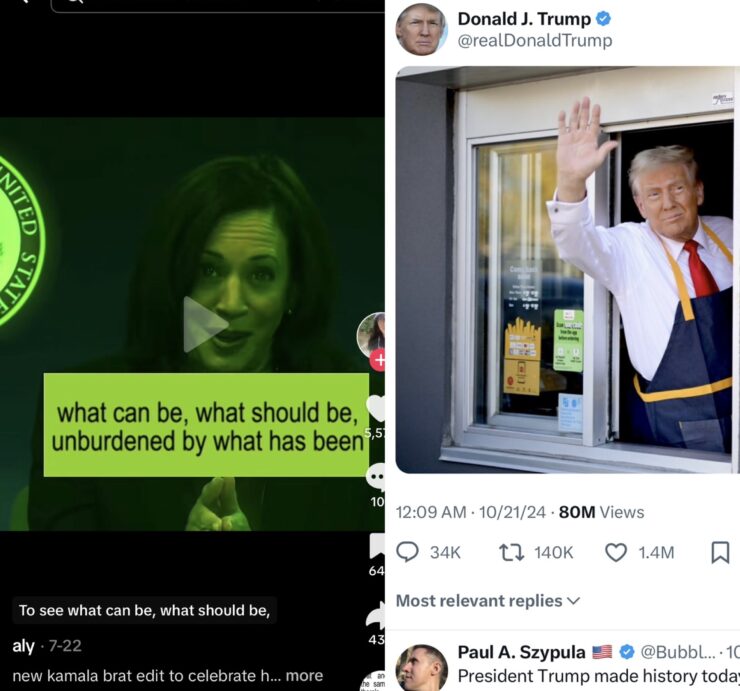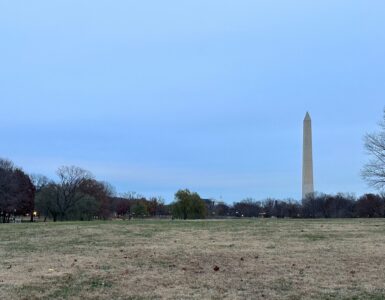As mail-in ballots begin to be counted and voters start trickling into early voting centers, American voters’ eyes will soon be concentrated on a couple of key voter groups.
One major category: young voters.
Democratic presidential nominee Kamala Harris, 60, and Republican nominee Donald Trump, 78, may be generations removed from voters in their late teens and 20s, but both campaigns are getting creative with social media to attract those voters.
How effective that campaigning work has been will be known soon, but young voters and pollsters said that, when used effectively, social media can reach Gen Z when little else can.
According to poll data released earlier this month by the Pew Research Center, adults under 30 are almost as likely to trust information from social media sites as they are information from national news organizations. While 56% of respondents noted trust in national news, 52% said they trust social media.
For young Democrats, social media efforts early in Harris’s campaign – including video clips dubbed over with her comments about falling out of a coconut tree and posts associating her with Charli XCX’s “Brat” album – proved to have staying power.
“I think that was really influential in kind of cementing the opinions of Vice President Harris among young voters,” said Matthew Vigneau, an American University junior who is the President of school’s College Democrats which has nearly 900 members.
While Vigneau is already a politically active young adult, he noticed friends who weren’t previously as tuned into politics sending him TikToks and Instagram reels about the campaigns.
Those posts may not have generated a vote on the spot, but they started a conversation.
Friends would say, “‘Hey, this is pretty good. Tell me more about this person,” Vigneau said. “The fun stuff kind of leads people down the rabbit hole to where they’re doing deeper dives on health care, the economy, reproductive rights, climate change. So I think like the fun stuff is kind of a good hook to get people in, to get them used to consuming political content.”
Social media driven campaigns hinge upon that kind of curiosity, said Alberto Medina of the Center for Information & Research on Civic Learning and Engagement, which studies youth civic engagement in the United States.
“There needs to be sort of a step two,” Medina said. “We often find like, ‘Okay, I see something. I get excited about maybe voting or learning more about a candidate. Do I have easy access to information to do that?’”
There’s a feedback loop, as well, Medina said. His team’s research found that younger voters may be more likely to turn out and vote when they get opportunities to engage in the media, respond to posts and create their own content.
Despite that, investing so much time and money into social media messaging is still a gamble. According to Medina’s team, 41 million members of Gen Z will be eligible to vote by Election Day. Harris’s campaign TikTok, Kamala HQ, has 4.8 million followers. Trump’s Truth Social account, where he shares much of his promotional media, has 7.9 million followers.
Images disseminated on social media have also been an effective tool for young conservative voters as well as Democrats. To Joel Pritikin a sophomore at American University who leads the 65 members of College Republicans, a standout was Trump’s recent spin as a McDonald’s worker.
“He’s showing that he’s getting on the ground with normal people,” Pritikin said.
Another inspiring social media moment for young Republicans was when Trump bore a triumphant expression as his face bled following an assassination attempt at a Pennsylvania rally.
“It shows that he’s not stoppable,” Pritikin said.
If these moments are simply a flash in the pan or contain a stronger power over voters, their actions will likely become better understood in the months and years of research following the election.
Anne Arundel Community College political science professor Dan Nataf directs the college’s Center for the Study of Local Issues. He recently started including young voters in his research on voting behavior in Anne Arundel County, Maryland’s most politically divided large jurisdiction. He wanted to track the effects of various kinds of messaging on his students and their peers.
For young voters, entertainment is one of the most effective tools, Nataf said.
“The TikTok generation, they value entertainment,” he said. “Information is secondary to the way in which it’s presented.”
Whether entertainment, information and voter activation can exist in concert for Gen Z will be decided Nov. 5. But it’s a near certainty that if investments in social media prove effective on young voters in either party, it’s something Americans will start seeing a lot more of in subsequent elections.
The next step is refining the way it’s used.
It’s “something that has to be mastered,” Nataf said.















Add comment